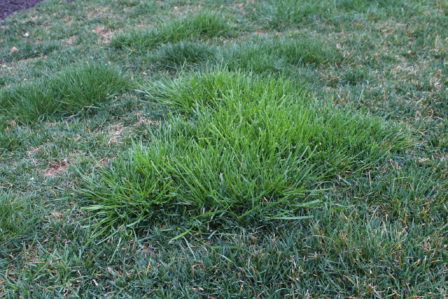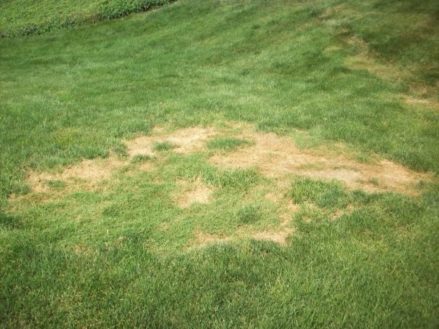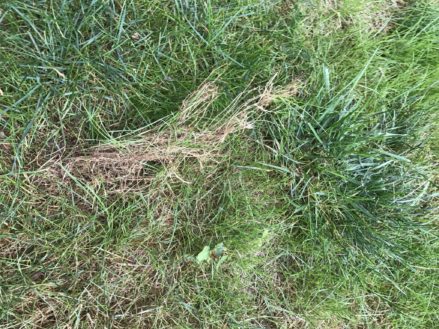One of the most common calls we get throughout the season is about “patchy” looking lawns. These calls can come from current clients or potential new clients. Rough bluegrass isn’t picky about whether you have lawn care or not.
 Background
Background
Rough bluegrass (poa trivialis) is native to Eurasia. This makes it a non-native, invasive species here in North America. It was likely brought to the US by early settlers for use in pastures and marshy areas.
Rough bluegrass is in the same family as Kentucky bluegrass, but grows differently. Kentucky bluegrass spreads by rhizomes (it puts out shoots underground). Rough bluegrass spreads through stolons (it puts out shoots over the top of the ground). Stoloniferous grasses tend to grow and spread more aggressively, like Bermuda, zoysia, or St. Augustine grasses do. This means that, under the right growing conditions, rough bluegrass will spread much more quickly than our native grasses, and can overtake portions of the lawn. This “crowding out” of native grasses is what causes rough bluegrass to look like there are these patches throughout the lawn.
What to look for
Poa trivialis grows best under very specific conditions. It grows most aggressively when the weather is cooler and damp. Soils with lots of moisture tend to be the places that you’ll see the largest strands of this grass. Because poa trivialis prefers that moisture, you’ll also most likely find it growing in parts of your lawn with shade.
Rough bluegrass doesn’t do very well with drought stress or heavy traffic. When the summer heat starts to arrive, and you’re actually using your lawn more often, that’s when these calls really begin in earnest. The higher temperatures combined with the foot traffic often make a patch of poa trivialis look like a turf disease or grub damaged lawn.
Management
There are couple of different options for managing rough bluegrass in the lawn, once you’ve identified it.
Mechanical
 You have some options for mechanical (non-chemical) management.
You have some options for mechanical (non-chemical) management.
If you’ve identified poa trivialis in the lawn (when stressed, it often looks like a pile of spaghetti), you can literally rake it up when it’s cool and the soil is moist. Do your best to pull it up by the roots as you rake. Another option is to get a flat shovel or a sod-cutter and remove the plant and root system together. Again, your best bet is to do this while the soil is damp and temperatures are cooler.
According to North Carolina State University, rough bluegrass is sometimes used on putting greens. The University of California advises mowing at 1” – 2.5” in height to encourage growth of poa trivialis. Why mention it? Rough bluegrass has a tendency to mat, or lay down flat, in a lawn. The remedy for many homeowners is to simply lower the height of their lawn mower. Mowing too close to the ground may encourage rough bluegrass to spread and grow! If you’re trying to eliminate it, make sure you’re not mowing too low.
Lastly, you can limit the spread of poa trivialis by managing the amount of water it gets. When we’re experiencing drought stress, water the lawn only enough to keep native grasses healthy. The drought-susceptible rough bluegrass will quit spreading so aggressively, and native grasses will have more of a chance to compete and spread.
Chemical
Both NC State and the Pennsylvania Department of Conservation of Natural Resources (DCNR) agree chemical management is an option. (The DCNR actually considers poa trivialis an “invasive plant.”)
For large areas where rough bluegrass has established, you’ll need to carefully treat it with a non-selective herbicide. Again, caution is important; non-selective herbicides kill everything, healthy turf included. Once the desired section of turf is controlled, you should still manually remove the remaining plant material and re-seed or sod the area.
For large sections or many different sections in the same lawn, you may want to consider contracting with a professional company licensed to use these products. This ensures less chance of harm to non-target plants or the environment.
Wrap-up
Rough bluegrass or poa trivialis is a pain to deal with. It’s a non-native, invasive species that often looks awful in our lawns. Management options include culture and mechanical practices, as well as chemical treatment.
If you have questions about managing rough bluegrass in your lawn and would like to speak with a professional for a free consultation, please Contact Us.
The post Why Does My Lawn Look Patchy? – Rough Bluegrass appeared first on Tomlinson Bomberger.
from Tomlinson Bomberger http://bit.ly/2IUo1Ye

No comments:
Post a Comment